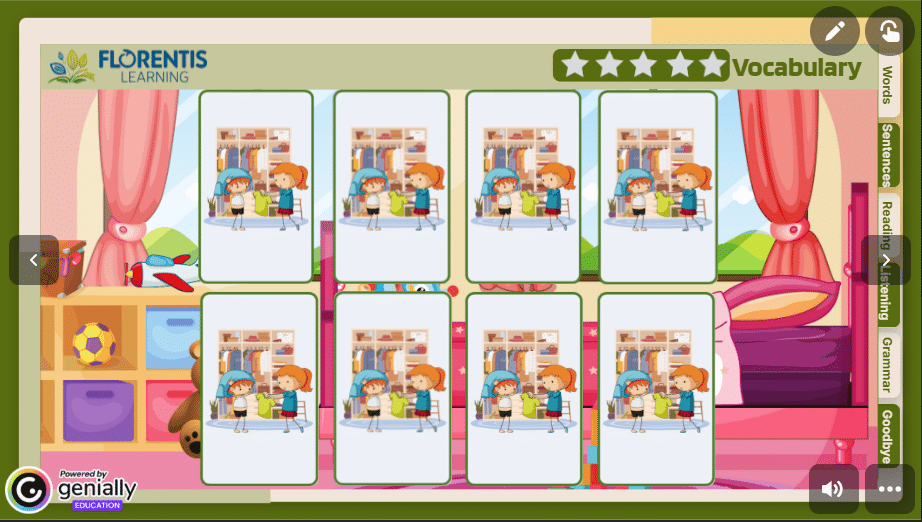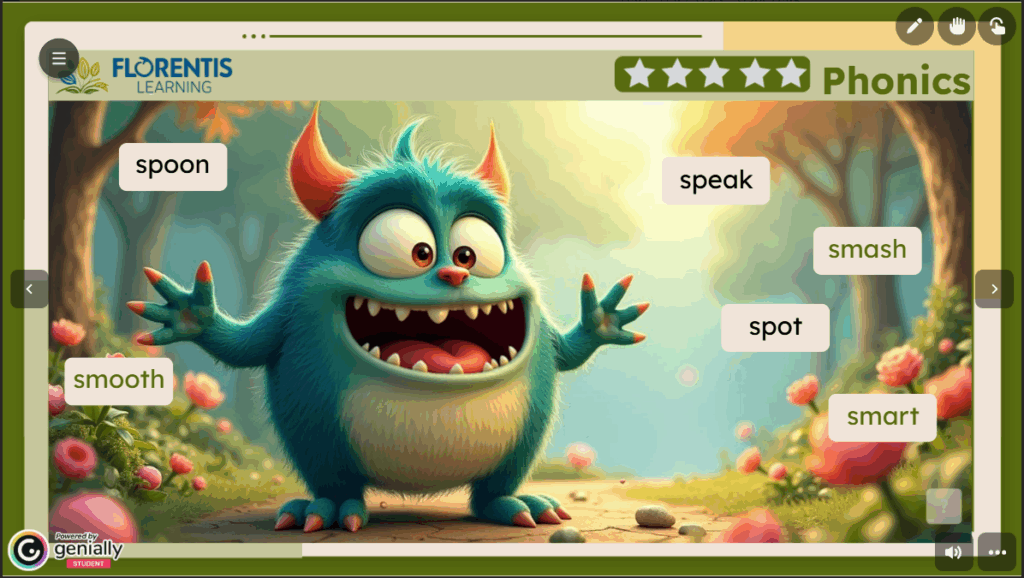Imagine your students eagerly logging in to class, excited not for video games—but to play virtual ESL vocabulary games that build real-world language skills. From “Feed the Monster” to “Mining Vocabulary,” each activity transforms routine review into playful, immersive learning. Research shows that gamified language instruction boosts motivation, enhances retention, and creates authentic learning environments—perfectly aligned with CEFR goals.
In this post, you’ll discover five engaging game ideas—and learn about gamified activities built into your Florentis Learning ESL curriculum—that elevate vocabulary acquisition from flashcard drudgery to dynamic interaction. Read on to learn how playful mechanics like monster-feeding, hidden-word hunts, and puzzle pieces can transform your virtual classroom and ignite your students’ language journey.
Why Vocabulary Games Truly Work
- Boost Retention Through Repetition & Context
Games repeatedly expose students to new words in playful contexts, helping move them from short‑term to long‑term memory. - Cultivate Active Learning & Motivation
Gamified activities foster friendly competition and intrinsic motivation—crucial in remote learning environments. - Encourage Collaboration & Communication
Many virtual vocabulary games rely on pair or teamwork, building both language fluency and social interaction.
“Games give students a low‑stress way to try out new words in real time.”
These methods align with Florentis’s ongoing focus on Vocabulary Instruction Strategies, such as cognitive mapping and word recognition activities.
Top 5 Virtual ESL Vocabulary Games
Virtual Pictionary
- What it is: Students draw a word while others guess it—ideal for visuals, nouns, and emotion words.
- Tools: Zoom/Teams Whiteboard, Google Jamboard
- Why it works: Combines visual cues with peer feedback, reinforcing word-meaning connections.
Teacher tip: Assign a student as a “timekeeper” to promote responsibility and natural use of vocabulary like “Wait!” and “I got it!”

Digital Memory Match
- What it is: Flip cards to find matching word–image or word–definition pairs.
- Tools: Quizizz, Kahoot!, or Wordwall
- Why it works: Enhances form–meaning pairing through retrieval practice.
Digital memory match games are one of the games that is incorporated into the Florentis Learning Complete ESL Curriculum lessons.

Word Association Chains
- What it is: Each student builds on a chain (“apple → fruit → healthy → doctor…”).
- Tools: Virtual whiteboard, breakout rooms for small groups
- Why it works: Enhances vocabulary networks and semantic clustering—great for word webs and Tier 2+3 expansions.
Pro tip: Challenge groups to include academic tier words to stretch their lexicon.
Vocabulary Race
- What it is: In breakout rooms, teams race to define, act out, sketch, or use target words in a sentence.
- Tools: Breakout feature in Zoom, Google Meet
- Why it works: Encourages speaking, quick recall, and creative use of vocabulary.
Bonus: Rotate tasks (define, sketch, act, use in sentence) for differentiation and higher student engagement.
5. Virtual Taboo
- What it is: One player describes the target word without using “banned” words listed onscreen.
- Tools: PowerPoint/Google Slides with hidden trigger words, shared via screen
- Why it works: Develops paraphrasing skills and deep processing.
Scaffold idea: Provide sentence stems like “It’s something you ___” for lower levels, or list only banned words for advanced learners.
Tips for Seamless Remote Classroom Integration
- Use Breakout Rooms – Ideal for collaboration, it also boosts speaking opportunities.
- Set Timers & Leaderboards – Build excitement and momentum.
- Incorporate Digital Rewards – Badges, stickers, or on-screen applause foster motivation. Florentis Learning incorporates built in ‘reward stars’ in our lessons to support digital rewards.
- Record & Reflect – Split-screen recording of whiteboard games provides opportunities for post-game review and vocabulary reflection.
- Foster Inclusivity – Pair stronger speakers with emerging learners for peer scaffolding.
Extend the Learning
- Homework Around Game Words: Ask students to journal with 3 game words.
- Create Class Word Walls: Use digital tools like Padlet or Google Slides to build a growing vocabulary collection.
- Family Involvement: Send home a “Family Game Guide” so parents can engage in a version of the game at home.
🚀 Making the Most of Florentis Learning: Playful Game Designs in Every Lesson
Every Florentis Learning lesson includes built-in vocabulary games. Across our platform, we’ve infused gamified activities that make vocabulary practice dynamic and fun:
🎲 ‘Feed the Monster’
Kids read a sight word, then “feed” it to a friendly monster. This fun, tactile motion encourages automatic word recognition—just like proven literacy apps that show strong early‑reading gains.

🧩 Puzzle‑Piece Word Game
Drag and assemble a puzzle, then voice the vocabulary word that emerges. It combines kinesthetic engagement with verbal recall, boosting memory retention—mirroring findings that digital games significantly aid ESL vocabulary learning.
⛏️ Mining Vocabulary
Click hidden words in a “mine,” pronounce each aloud, and drag it into a mining cart. This multi-step process—visual search, pronunciation, and motor action—supports deep processing, known to improve recall.
🌄 Hidden Vocabulary Hunt
Students uncover words by clicking on rocks and hills, reveal flashcards, say them aloud, and clear the “landscape.” This element of surprise builds intrinsic motivation and engagement—features shown to enhance retention in ESL contexts
🎯 Why They Work
- Multisensory Engagement: Each game combines visual, auditory, and motor interaction—key to embedding vocabulary in long-term memory.
- Play‑to‑Learn Mechanics: Features like “feeding a monster” or “mining for words” tap into children’s natural drive to explore—a powerful motivator backed by literacy research.
- Contextual Recall: Games like these encourage students to recognize, pronounce, and use words in context—showing higher vocabulary retention than rote memorization.
Learn more about the research behind the importance of games to help students learn vocabulary in the article Developing Vocabulary in Game Activities and Game Materials by Esra Akdogan.
By blending built-in matching games with creative activities like puzzles, monsters, mining, and treasure hunts, Florentis Learning ensures that every CEFR-aligned lesson becomes a rich, memorable learning experience—not just another quiz.
Conclusion
Virtual ESL vocabulary games—like matching pairs, monster-feeding, hidden-word hunts, and puzzle-matching—encourage students not just to recognize words but to actively use them in engaging, context-rich ways. When learners reflect on which words were easy and which challenged them, they become co-creators of their own progress—an essential mindset for moving through the CEFR levels. Gamified vocabulary connects vivid experiences (like “feeding a monster”) to language use, boosting motivation and memory far beyond simple drills.
Your Next Step:
📝 After your next game activity, ask: “Which words did you remember best, and which were tricky?” Use these reflections to tailor your next review lesson—embed the students’ feedback into your own curriculum decisions.
Try It in Action: Free CEFR-Aligned Sample Lessons
Ready to test these gamified strategies in real ESL lessons? Sign up for Florentis Learning’s Free Sample Pack, featuring 16 ready-to-teach CEFR-aligned lessons across Pre-A1 through B2. These lessons come complete with interactive games, printable worksheets, and clear teacher notes—so you can experience firsthand how vocabulary learning comes to life:
- Level-appropriate “Feed the Monster,” puzzle, and matching activities
- Speaking, listening, and writing tasks woven into each lesson
- Easy-to-adapt tools for Zoom-style platforms, co-browsers such as Koala Go or in-person settings
Ready to gamify your classroom?
🔗 Enroll in the Free Sample Pack now and discover how joyful, memorable, and effective virtual ESL vocabulary games can be.


Leave a Reply